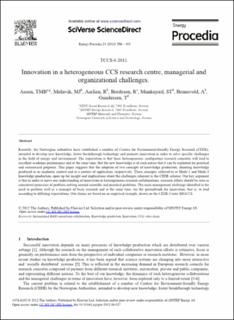| dc.contributor.author | Aasen, Tone Merethe | |
| dc.contributor.author | Mølnvik, Mona J. | |
| dc.contributor.author | Aarlien, Rune | |
| dc.contributor.author | Bredesen, Rune | |
| dc.contributor.author | Munkejord, Svend Tollak | |
| dc.contributor.author | Brunsvold, Amy | |
| dc.contributor.author | Gundersen, Truls | |
| dc.date.accessioned | 2020-12-15T13:10:54Z | |
| dc.date.available | 2020-12-15T13:10:54Z | |
| dc.date.created | 2012-09-07T14:20:58Z | |
| dc.date.issued | 2012 | |
| dc.identifier.citation | Energy Procedia. 2012, 23 296-305. | en_US |
| dc.identifier.issn | 1876-6102 | |
| dc.identifier.uri | https://hdl.handle.net/11250/2719579 | |
| dc.description.abstract | Recently, the Norwegian authorities have established a number of Centres for Environment-friendly Energy Research (CEER), intended to develop new knowledge, foster breakthrough technology and promote innovation in order to solve specific challenges in the field of energy and environment. The expectation is that these heterogeneous, multipartner research consortia will lead to excellent academic performance and at the same time, that the new knowledge is of such nature that it can be exploited for practical and commercial purposes. This paper suggests that the adoption of two concepts of knowledge production, denoting knowledge produced in an academic context and in a context of application, respectively. These concepts, referred to as Mode 1 and Mode 2 knowledge production, open up for insight and implications about the challenges inherent in the CEER scheme. Our key argument is that in order to move our understanding of innovation in heterogeneous research collaborations, research efforts should be seen as concurrent processes of problem solving around scientific and practical problems. The main management challenge identified is the need to perform well as a manager of basic research and at the same time, lay the groundwork for innovation, that is, to lead according to differing expectations. Our claims are based on an empirical example, drawn on the CEER Centre BIGCCS. | en_US |
| dc.language.iso | eng | en_US |
| dc.publisher | Elsevier | en_US |
| dc.rights | Attribution-NonCommercial-NoDerivatives 4.0 Internasjonal | * |
| dc.rights.uri | http://creativecommons.org/licenses/by-nc-nd/4.0/deed.no | * |
| dc.subject | CO2 value chain | en_US |
| dc.subject | Innovation | en_US |
| dc.subject | Knowledge production | en_US |
| dc.subject | International R&D consortium collaboration | en_US |
| dc.title | Innovation in a heterogeneous CCS research centre, managerial and organizational challenges | en_US |
| dc.type | Peer reviewed | en_US |
| dc.type | Journal article | en_US |
| dc.description.version | publishedVersion | en_US |
| dc.rights.holder | © 2012 The Authors. Published by Elsevier Ltd. Selection and/or peer-review under responsibility of SINTEF Energi ASdoi: 10.1016/j.egypro.2012.06.027 | en_US |
| dc.source.pagenumber | 296-305 | en_US |
| dc.source.volume | 23 | en_US |
| dc.source.journal | Energy Procedia | en_US |
| dc.identifier.doi | 10.1016/j.egypro.2012.06.027 | |
| dc.identifier.cristin | 943014 | |
| dc.relation.project | Norges forskningsråd: 193816 | en_US |
| cristin.unitcode | 7548,60,0,0 | |
| cristin.unitcode | 7401,80,3,0 | |
| cristin.unitname | Gassteknologi | |
| cristin.unitname | Bærekraftig energiteknologi | |
| cristin.ispublished | true | |
| cristin.fulltext | original | |
| cristin.qualitycode | 1 | |

